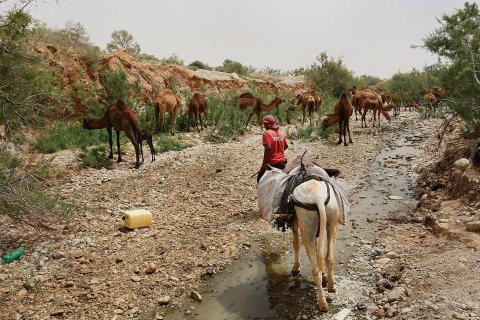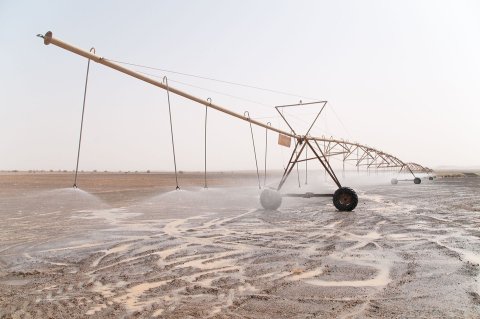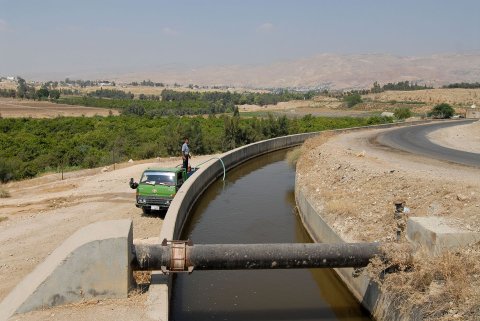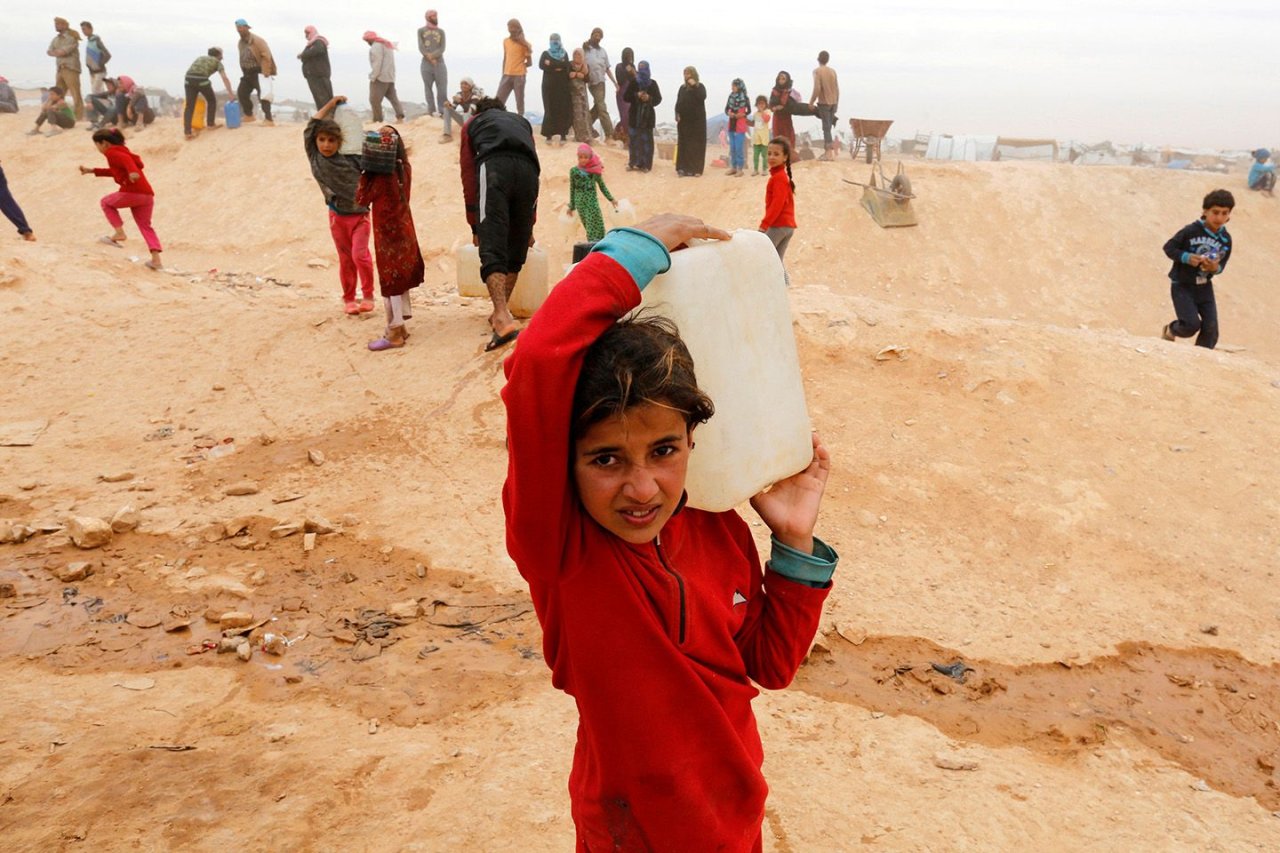Summer is always scorching in Amman, Jordan, but last July was particularly brutal for Tarek el-Qaisi, a mechanic who lives with his family in the eastern part of the city. A gang of thieves tapped into the power lines across from his home, and the electricity provider cut off the entire street for a fortnight. With no fans or fridges, the treeless, concrete neighborhood felt like a blast furnace. The next day, a nearby sewage pit backed up, enveloping his apartment with a sickening stench. The flies loved it, but all three of el-Qaisi's school-age children got sick. By the time his boss lowered his salary, citing slow business, the young mechanic thought nothing could faze him. "It's hell," he says, "but it's not like we have a choice."
The sudden loss of his water supply, however, has left him nearly hopeless. With no municipal water access, el-Qaisi and his neighbors have always had to rely on private tanks to service their cisterns. But recent construction at the foot of the hill on which they live has severed that lifeline. The whale-size trucks can no longer get close, so residents are now dependent on what they can carry up the steep, uneven roads. Unable to properly wash their clothes or even clean dishes, they're slowly reconciling themselves to a world with almost no water. "I come home dirty and sometimes can't wash," says el-Qaisi, his arms and face flecked with sweat and motor oil. "It's humiliating. No one should have to live like this."
Supply and Demand
Without drastic action, many Jordanians may share his plight. The Jordan River, the country's lone waterway, is dirty and depleted, while some of its aquifers have been pumped almost beyond repair. The nation's annual rainfall is set to slide dramatically due to climate change, even as its population continues to swell. Jordan is too poor to turn to costly, large-scale desalination—or fix its leaky infrastructure. And the country's population growth shows few signs of slowing, so it can't fall back on water imports, as some lightly populated Pacific and Caribbean island nations have done. Water shortages have gotten so bad, they've already sparked clashes between refugees and native Jordanians, and the officials charged with catering to booming demand with a shrinking supply are beginning to panic. "We have to look outside Jordan," says Ali Subah, secretary-general for strategic planning at the Ministry of Water and Irrigation. "There are no more water resources here."
Jordan could be the first country to run out of water, but it likely wouldn't be the last. Globally, water demand is forecast to rise by roughly 50 percent by 2050. And the situation is dire on the supply side too: 21 out of the world's 37 biggest aquifers are already moving past their tipping points, according to NASA, in part due to over-extraction for drinking water and mining. Meanwhile, global warming appears to be reducing rainfall in some places. Two out of every three people will face water shortages by 2025, the World Meteorological Organization says, and hundreds of millions more might grapple with dangerously poor water quality.

Overwhelmed by the challenge of supplying their swelling populations with often shoddy infrastructure, many of the planet's megacities are particularly at risk. Four billion people currently live in urban areas, a total that's expected to almost double by the middle of the century. Nairobi, Kenya, almost ran dry this summer, while Cape Town, South Africa, is in the throes of its worst drought in many years. Tehran, Iran, looks set to introduce water rationing soon. And in the U.S., too, water managers in 40 states expect water woes over the next decade. At best, water shortages could set the global economy back $500 billion a year, according to the World Bank. At worst, they could lead to war and terrorism. As a comprehensive 2012 U.S. intelligence report put it: "The use of water as a weapon or to further terrorist objectives also will become more likely beyond 10 years."
In the Middle East, that warning is especially worrisome in the aftermath of the 2011 Arab Spring revolts. As in much of the region—and the world—most of Jordan's water, at least 65 percent, goes to agriculture. And some officials recognize that this is unsustainably high. "We can't tell the next generation that we lost all your water because we grew too many tomatoes," a senior royal courtier said on the condition of anonymity, as he was not authorized to speak to the press. In the royal palace, a heavily wooded and guarded swath of central Amman, teams of specialist advisers pore over the country's options. But in a precarious region, policymakers are loath to surrender all food production. "In some ways, this has happened since time immemorial," says Aaron Wolf, a professor of geography and noted water expert at Oregon State University. "If you're rich, you resolve [the crisis]. If you're poor, you die."
Jordan has never had much water. But for most of history, its relatively few inhabitants got by. Seventy years of mopping up its much larger neighbors' mess changed all of that. First, several hundred thousand Palestinian refugees fled over the border following the creation of Israel in 1948, two years after Jordan's founding, almost tripling the new state's water requirements overnight. Then waves of Lebanese, Iraqis and more Palestinians followed over the subsequent decades, each adding to the burden. Many refugees from war-ravaged Libya and Yemen also moved to Amman in recent years. By the time the civil war in Syria worsened in 2013, ultimately saddling its southern neighbor with over a million of its thirsty citizens, there was almost no Middle Eastern nationality Jordan hadn't hosted.
Native Jordanians have played their part in the population growth too. The country has a fertility rate of 3.38, one of the highest in the region.
This population boom alone, however, didn't doom Jordan's water supply, government strategists say. (Though they insist the Syrian refugees, who come from a less arid land, have little understanding of water conservation practices.) But with much of the growth coming in sudden influxes, authorities have been unable to properly plan from one year to the next.
And so, as Jordan's population has continued to outpace all projections, besting the 2035 forecast of 9 million as early as 2015, stunned officials have resorted to raiding all water sources in sight—to devastating effect. Ten of the country's 12 aquifers are now almost depleted, says Maysoon Zoubi, head of the Higher Population Council and a former secretary-general of the Ministry of Water and Irrigation. In some places, water engineers are drilling down over a mile in pursuit of new discoveries. Authorities don't have a choice, experts say. "The water quality is going down, the water quantity is going down, but you need to provide water for people," says Raed Nimri, a water expert at Mercy Corps and deputy head of Water Innovations and Technologies, a U.S.-funded water-saving program. "This is a national security issue."
At 90 cubic meters per person per year, one of the lowest per capita water shares in the world, Jordanians enjoy about 3 percent of Americans' consumption. But the country is far from blameless regarding its water plight. Perhaps half of all extracted water is lost to leaky pipes; in some otherwise dry districts of Amman, gushing jets of freshwater irrigate the concrete. It's a self-inflicted wound of crippling proportions. Because of holes in the distribution network, water station operators have to pump furiously to maintain pressure in the pipes, so more is squandered in transit. In fact, almost 20 percent of Jordan's electricity goes to pumping and circulating water around the country, according to the Ministry of Water and Irrigation. Despite this massive expense, the flow is often so feeble by the time it reaches residents, many of whom receive municipal water access only every few weeks, they don't have enough time to fill the rooftop tanks they use to tide themselves over until the next delivery. "The streets are getting the water we need!" says Samir Kukh, a retired civil servant, who lives in the capital's Bayader neighborhood.
Theft is also exacting a heavy toll. For decades, a wealthy and connected cabal of major families and tribal leaders have exploited Jordan's water resources. Conscious of the monarchy's dependence on their political support, they've helped themselves to torrents of free water without fear of reproach. "There's political interference because some of the big families have their farms," says Zoubi. At least 30 million cubic meters are lost to illegal wells every year, according to the Ministry of Water and Irrigation, though independent experts suspect the total might be much higher.
So at the same time as severe water shortages pitch Syrian refugees and Jordanians into conflict with each other, particularly around Ramtha in the north, these powerful landowners are guzzling groundwater. "In a country that might run out of water," says Mohammed Atiyeh, a farmer in the southern Jordan Valley, "there is regulation only for the weak and poor."

'Praying to God for Help'
Located in the valley, with its famously fertile soil, several hundred meters below sea level, Atiyeh's farm ought to be blooming. But with a water supply that's one-fifth as salty as seawater, he can't grow anything but sickly looking palm trees. And with his neighbor, a scion of one of the area's leading families, hoarding what's left of the freshwater to irrigate his banana trees, Atiyeh worries he might soon be unable to grow anything at all.
Others face a far direr situation. Several miles to the south, along the Dead Sea, sinkholes have already consumed some fields. With next to no Jordan River water now reaching the lake, the lowest place on Earth, surface levels are falling by around a meter a year, taking everything from roads to rice crops with them. At some spas on the Israeli side of the Dead Sea, operators now rely on tractor-drawn trailers to ferry guests over half a mile to the beach.
Because of climate change, Jordan's water shortage could soon get dramatically worse. The little rain the country receives is projected to drop 30 percent by the end of the century, according to Stanford University's Jordan Water Project. Soil will dry out, reducing yields. As supply hits new lows and demand soars—particularly in agriculture, as much higher temperatures lead to more evaporation and thirstier crops—even royals are bracing themselves for trouble. "Although Jordan contributed very little to the imminent impact of climate change, it is nevertheless expected to suffer on a much higher level compared to other countries," says Prince Hassan bin Talal, the king's uncle and former chairman of the U.N. Secretary-General's Advisory Board on Water and Sanitation. Even with present levels of precipitation, Jordan has never filled more than 60 percent of its dam and reservoir network.
And then there's the continued fallout from the kingdom's unfortunate topography. Downstream of Syria and Israel, and with its biggest aquifers spanning the Saudi and Syrian borders, Jordan has always been at the mercy of its neighbors' water policies. Since the 1950s, dam construction and agricultural expansion in Syria have cut the volume of the Yarmouk, the Jordan River's principal tributary, by at least 60 percent. The Wehda Dam, Jordan's big barrage on the Yarmouk, has rarely been more than a quarter full . But authorities in Amman haven't seen anything yet, Stanford researchers say. Regionwide drought and upstream population growth could shrink Jordan's share of the Yarmouk up to 75 percent by 2050, while likely further cutting its groundwater access. With less rain, little river water, more people and already ailing aquifers, the numbers are no longer adding up. "We are praying to God for help," says Sobhi al-Abadi, one of an estimated 30,000 water tank drivers who service unconnected homes and businesses across the capital area. "Because nothing [else] will help us here."
Every morning, starting at 4 a.m., he and dozens of other truckers wait up to five hours to fill their tanks at Sharat, a well just south of Amman. From there, they spread out across the city, waiting for their phones to ring. Most neighborhoods have at least five or six wait stations, where the drivers can pull up and doze. But each year, business gets more challenging, al-Abadi and his colleagues say. Gas prices have gone up, raising their costs, at the same time as the "big families" with their private wells undercut the market. It's seemingly only the brutal summer heat, which boosts demand, that enables them to break even. "We thought this was a safe job because if someone runs out of water, they're going to do everything they can to buy more," Abadi says. "We're not so sure anymore."
Attacking the Crisis
Jordan does, however, have a few earthly options. The state is getting more serious about tackling the causes of its crisis—from launching family-planning campaigns to raising water prices and cracking down on bigwig water barons. "Some people will still be above the law, but there has been a drive to reduce their number and hopefully their impact," says Samer Talozi, a professor at the Jordan University of Science and Technology and member of the Stanford Water Project. Residential water prices have already gone up threefold over the past few years, from around $8 to $25 per quarter, though the World Bank says water is still underpriced. Aid and development organizations, like Mercy Corps, have even enlisted imams to encourage water conservation in their Friday sermons.
And there are some signs that the state is finally recognizing the necessity of reforming its agricultural sector. Already, about a quarter of farms operate off treated wastewater; there are plans to double that figure. Making the move away from conventional crop cultivation toward hydroponics and other water-saving farming techniques, as most experts believe the kingdom must eventually do, will be politically complicated, but Jordan has the necessary top-down system to pull it off. "If the king supports something, that means the Cabinet supports something," says Subah, the water and irrigation official.

In a rocky, windswept portion of the southern Jordanian desert, the Sahara Forest Project, a Norwegian venture, offers something of a template for how Jordan might maintain some food production despite its water shortage. Its model, one of the first of its kind in the world, involves piping water from the nearby Red Sea, desalinating it with solar-powered technology and then recycling it among greenhouses. With no ground, rain or surface water, they envisage growing an initial 130 tons of vegetables a year.
These reforms are necessary, but in the long term, none will be sufficient to make up for Jordan's water deficit, particularly if, as is the country's experience, the Syrian refugees don't go home. Jordan's current water budget is a little under a billion cubic meters, but by 2025, it's forecast to hit at least 1.4 billion. Only large-scale desalination, it seems, will give the kingdom a chance to satisfy its needs. "At one point, it has to happen," says Nimri of Mercy Corps. "If you want to come to a point where you don't run out of water, it has to happen."
One of the most ambitious schemes, known as the Red to Dead project, involves taking water from the Red Sea, desalinating it and dumping the brine into the Dead Sea to slow its disappearance.
But for these grand plans to work, Jordan, already one of the biggest beneficiaries of American assistance, is going to need a lot more outside help. The U.S. Agency for International Development has spent over $800 million on water projects in Jordan since 2000. The government in Amman is more or less broke, while the country's layout—with a short coastline that's downhill and a long way away from the main population centers—is uniquely ill-suited to cost-effective desalination. "The massive investment required to act...exceeds Jordan's resources by far," says Prince Hassan. "The help of the international community is essential to overcome the water problems."
Still, few would bet against the kingdom. It has displayed remarkable survival instincts in the past, remaining stable as its neighbors have wobbled. Even when faced with its greatest challenge, there's reason to believe it can do it again. "We're a country of refugees," says el-Qaisi, the water-deprived mechanic, showing off a modified shopping cart with which he and his neighbors plan to ferry large tanks of water up their hill. "And refugees," he adds, "are survivors."














